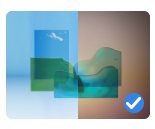Can't make the date? If you come to this page before or after the test day is completed, your testing is still valuable, and you can use the information on this page to test, file any bugs you find at
Bugzilla, and add your results to the results section. If this page is more than a month old when you arrive here, please check the
current schedule and see if a similar but more recent Test Day is planned or has already happened.
What to test?[edit]
This Test Day will focus on the desktop backgrounds / wallpapers shipped in Fedora 36. There are two main sets of backgrounds we'd like tested:
- The default Fedora 36 background - we did not make the beta media so we'd like folks to test the background and note their monitor(s) and resolution(s) and desktop environments(s) to ensure it looks acceptable. The "fedora" text logo in the lower right corner (under GNOME) should be visible. Users of the GNOME desktop will also have the opportunity to test the new "dark mode" feature which this wallpaper supports.

- The extra wallpapers included by default with Fedora 36 - these also did not make the meta media. There is a set of 12 installed-by-default but not set as default wallpapers that will ship with Fedora 36. 6 of these are abstract wallpapers provided by GNOME upstream, and 6 are Fedora community submitted photographic wallpapers. All of this set of 12 wallpapers supports the new dark mode in Fedora Workstation / GNOME. we'd also like folks to test these backgrounds and note their monitor(s) and resolution(s) and desktop environments(s) to ensure it looks acceptable.


Who's available[edit]
The following cast of characters will be available testing, workarounds, bug fixes, and general discussion:
You can chat with us on the Fedora Design channel on fedora.im https://matrix.to/#/#design:fedoraproject.org. See the infobox on top of the page to learn the right IRC channel.
Máirín Duffy (mizmo) and Madeline Peck (madelinepeck) will have live office hours from 1700-1800 UTC (1-2 PM US Eastern Time) during this test day in the Fedora Design Matrix channel accessible via this link https://matrix.to/#/#design:fedoraproject.org or via the IRC link at the top of this page.
Prerequisite for Test Day[edit]
- A virtual machine or a bare metal machine
- An installation of a recent Fedora 36 Nightly (any Edition or Spin). Make sure to fully update your system. If installing a fresh system, it's recommended to use the latest nightly image. The nightly images *should* have all of the updated wallpapers in needed of testing by the test day - the March 28, 2022 nightly was tested and did indeed have them.
How to test?[edit]
This isn't too intensive a test process. We need your help trying out these wallpapers using your desktop environment of choice with your monitor / resolution to simply make sure they look OK. For those using GNOME, we'd like you to test both the light and dark modes of the wallpapers.
Please note your monitor resolution and the desktop environment you are testing the wallpapers under.
Log your results on our event's page on the test days app: https://testdays.fedoraproject.org/events/130
Things to look for depending on the wallpaper you're viewing:
The default Fedora 36 background[edit]

- The "fedora" text logo in the lower right corner (under GNOME) should be visible and readable.
- Users of the GNOME desktop should be able to enable "dark mode" and "light mode" on this wallpaper and test both versions.
- When set as the active wallpaper, the wallpaper should not hurt your eyes or be overly distracting as you engage with the desktop.


- Users of the GNOME desktop should be able to enable "dark mode" and "light mode" each of these 12 wallpapers and test both versions.
- When set as the active wallpaper, the wallpaper should not hurt your eyes or be overly distracting as you engage with the desktop.
Please also try to experiment and explore and perform tasks not mentioned in any of the pre-defined test cases. If anything stands out to you as something that appears wrong or broken about the wallpapers, please report it.
Reporting bugs[edit]
Bugs with the Default Wallpaper[edit]
 Bugs related to the default wallpaper should be reported into Bugzilla, in most cases against the
Bugs related to the default wallpaper should be reported into Bugzilla, in most cases against the f36-backgrounds component.
 Bugs related to the photographic extra wallpapers should be reported into Bugzilla, in most cases against the
Bugs related to the photographic extra wallpapers should be reported into Bugzilla, in most cases against the fedora-workstation-backgrounds component.
 Bugs related to the abstract extra wallpapers should be reported into Bugzilla, in most cases against the
Bugs related to the abstract extra wallpapers should be reported into Bugzilla, in most cases against the gnome-backgrounds component.
If you are unsure about exactly how to file the report or what other information to include, just ask us on IRC / Matrix (see instructions above).
Test Results[edit]
Test results will be exported here once the test day is over. See How to test? section for information how to submit results and see the live results.
For some reason I can't load these into the test days app right now so -
Installation[edit]
| User
|
Profile
|
Virtual install
|
Bare Metal install
|
References
|
| Daniels
|
QEMU - KVM (fedora-coreos-36.20220410.1.1-live.x86_64.iso) Host: Gnome 41.5 Intel® Pentium(R) CPU 4415U @ 2.30GHz × 4 Lenovo 2in1 14
|
 pass pass [1]
|
|
- ↑ ssh ((port (core@localhost) access denied to 127.0.0.1:2222. coreos 410))
Earlier versions of Coreos : 2022313.325. 327: Virtual Install. (No Pass)
librvirt test Installs (OS: fedora-coreos-next, not recognized ) Smooth testing otherwise.
|
| Nemric
|
PXE installation
|
|
 pass pass [1]  pass pass [2]
|
- ↑ Configured swap on Zram with default settings
- ↑ Running : 1) docker.io/grafana/promtail:latest instance 2) quay.io/prometheus/node-exporter:latest instance 3) docker.io/library/registry:latest and docker.io/library/redis:latest in a pod
|
| andilinux
|
|
|
 pass pass
|
|
| andilinux
|
GNOME BOXES
|
 pass pass [1]
|
|
- ↑ Fedora CoreOS next
all worked fine for me
|
| bittin
|
FCOS next image
|
|
 pass pass
|
|
| bittin
|
FCOS next image in Virtualbox
|
 pass pass  fail fail
|
|
|
| checking
|
FCOS next image
|
 pass pass
|
|
|
| danniel
|
FCOS next image
|
 pass pass
|
|
|
| donaldsebleung
|
FCOS next image with QEMU; arch: x86_64; custom Ignition file with password-based SSH access; launching with QEMU
|
 warn warn [1]  pass pass [2]
|
|
|
| dustymabe
|
Installed FCOS next on Intel NUC
|
|
 pass pass
|
|
| ersen
|
virt-manager
|
 pass pass
|
|
|
| geraldosimiao
|
FCOS next image
|
 pass pass [1]
|
|
- ↑ tested qemu qcow and iso image too
|
| kisk
|
fedora-coreos-36.20220325.1.0-qemu.x86_64.qcow2.xz - libvirt
|
 pass pass
|
|
|
| lnie
|
fcos next image,x86_64,VM created by testcloud
|
 pass pass
|
|
|
| lruzicka
|
QEMU
|
 pass pass [1]
|
|
|
| millerthegorilla
|
|
 warn warn [1]  fail fail [2]  fail fail [3]
|
 fail fail [4]  warn warn [5]  fail fail [6]
|
- ↑ these were both the x86_64 image
- ↑ mounted virtual image as per https://gist.github.com/shamil/62935d9b456a6f9877b5 (Mount qcow image), and installed using https://docs.fedoraproject.org/en-US/fedora-coreos/bare-metal/#_installing_from_the_container. Installer ran fine, sshd in, and no ip address was reported on screen. got the ip address from virt-manager and ssh'd in. Seems to be working, tried machinectl shell to open standard user from ignition file, worked fine.
- ↑ started live cd install using virt-manager. Started ok, to prompt, but when trying to run coreos-installer picking up config.ign from the local network, the install failed with 'error checking whether /dev/sda is an ibm dasd disk.' Output of lsblk is garbled, with disk listed as '^%\xef\x9aaU'. Perhaps related to this (https://discussion.fedoraproject.org/t/coreos-pxeboot-coreos-installer-cant-format-dev-vda-or-dev-sda/25680)
- ↑ edk2 install failed to present a network address to the internet, wired connection not recognised by router.
- ↑ Docs for uboot at (https://docs.fedoraproject.org/en-US/fedora-coreos/provisioning-raspberry-pi4/#_installing_fcos_and_booting_via_u_boot) assume a non rpm-ostree install on the host machine. Ie there is no dnf available on my silverblue laptop, and I couldn't figure how to install using toolbox (perhaps I should have used a --privileged flag to podman).
The docs for EDK (https://docs.fedoraproject.org/en-US/fedora-coreos/provisioning-raspberry-pi4/#_edk2_combined_fedora_coreos_edk2_firmware_disk), should probably invite the user to expand their xfs partition before mounting. In my experience, only gparted has the capacity to do this correctly without too much hassle.
- ↑ install on pi4b following instructions for edk2 at [fedora-docs](https://docs.fedoraproject.org/en-US/fedora-coreos/provisioning-raspberry-pi4/#_edk2_combined_disk_mode_alternate_machine_disk_preparation) - boot loads, after very long pause at grub boot screen 'booting coreos-vernum' , No IP address is shown, and SSH host key is displayed, 3 times, one for ecdsa, one for ed25519 and one for RSA. What are these host keys, and why are they displayed?
|
| pnemade
|
FCOS next image
|
 pass pass
|
|
|
| sayaksarkar
|
GNOME Boxes
|
 pass pass
|
|
|
| sumantrom
|
QEMU
|
 pass pass
|
|
|
Cloud launch[edit]
| User
|
Profile
|
AWS
|
Azure
|
GCP
|
DigitalOcean
|
VMWare
|
Exoscale
|
IBM Cloud
|
VirtualBox
|
Vultr
|
OpenStack
|
Alibaba
|
References
|
| alciregi
|
DigitalOcean droplet
|
|
|
|
 pass pass [1]  warn warn [2]
|
|
|
|
|
|
|
|
- ↑ ok, works (in the documentation: in doctl compute image create the "--wait" option thorws an error)
- ↑ Droplet creation successfully. Can't ssh: I don't know if it is a problem on my side (ssh key, ignition file) or what else. Will try again later
|
| danniel
|
FCOS next image
|
|
|
|
|
 pass pass
|
|
|
|
|
|
|
|
| donaldsebleung
|
Fedora CoreOS 36 Next stream (arch: x86_64; ami: ami-066680d6ebe90fce1) on AWS
|
 pass pass [1]
|
|
|
|
|
|
|
|
|
|
|
|
| donaldsebleung
|
Fedora CoreOS 36 Next stream (arch: x86_64; instance type: e2-micro) on GCP
|
|
|
 pass pass [1]
|
|
|
|
|
|
|
|
|
|
| dustymabe
|
36.20220410.1.1 on s-2vcpu-2gb droplet in nyc3
|
|
|
|
 pass pass
|
|
|
|
|
|
|
|
|
| dustymabe
|
exoscale
|
|
|
|
|
|
 fail fail [1]
|
|
|
|
|
|
|
| dustymabe
|
ibmcloud bx2-2x8 instance
|
|
|
|
|
|
|
 pass pass
|
|
|
|
|
|
| fifofonix
|
|
|
|
|
|
 pass pass [1]
|
|
|
|
|
|
|
|
| jdoss
|
|
|
|
 pass pass [1]
|
|
|
|
|
|
|
|
|
- ↑ Fedora CoreOS 36.20220325.1.0 launched just fine on GCP with a e2-medium instance in us-central1-a
|
| miabbott
|
FCOS 36 on Aliyun
|
|
|
|
|
|
|
|
|
|
|
 pass pass [1]
|
- ↑ Used fedora-coreos-36.20220325.1.0-aliyun.x86_64.qcow2
|
| mnguyen
|
|
|
 pass pass [1]
|
|
|
|
|
|
|
|
 pass pass [2]
|
|
|
| ravanelli
|
Fedora CoreOS 36 Next stream (arch: x86_64) on VirtualBox
|
|
|
|
|
|
|
|
 pass pass [1]
|
|
|
|
|
| sayaksarkar
|
fedora-coreos-36.20220325.1.0-live.x86_64.iso
|
|
|
|
|
|
|
|
 pass pass
|
|
|
|
|
| sohank2602
|
Fedora CoreOS 36 Next stream (arch: x86_64) on Vultr
|
|
|
|
|
|
|
|
|
 pass pass [1]
|
|
|
|
aarch64[edit]
| User
|
Profile
|
AWS
|
Virtual install
|
Bare Metal install
|
References
|
| Daniels
|
QEMU - KVM (fedora-coreos-36.20220410.1.1-live.x86_64.iso) Host: Gnome 41.5 Intel® Pentium(R) CPU 4415U @ 2.30GHz × 4 Lenovo 2in1 14
|
|
 pass pass [1]
|
|
- ↑ ssh ((port (core@localhost) access denied to 127.0.0.1:2222. coreos 410))
Earlier versions of Coreos : 2022313.325. 327: Virtual Install. (No Pass)
librvirt test Installs (OS: fedora-coreos-next, not recognized ) Smooth testing otherwise.
|
| Nemric
|
PXE installation
|
|
|
 pass pass [1]  pass pass [2]
|
- ↑ Configured swap on Zram with default settings
- ↑ Running : 1) docker.io/grafana/promtail:latest instance 2) quay.io/prometheus/node-exporter:latest instance 3) docker.io/library/registry:latest and docker.io/library/redis:latest in a pod
|
| andilinux
|
|
|
|
 pass pass
|
|
| andilinux
|
GNOME BOXES
|
|
 pass pass [1]
|
|
- ↑ Fedora CoreOS next
all worked fine for me
|
| bittin
|
FCOS next image
|
|
|
 pass pass
|
|
| bittin
|
FCOS next image in Virtualbox
|
|
 pass pass  fail fail
|
|
|
| checking
|
FCOS next image
|
|
 pass pass
|
|
|
| danniel
|
FCOS next image
|
|
 pass pass
|
|
|
| donaldsebleung
|
FCOS next image with QEMU; arch: x86_64; custom Ignition file with password-based SSH access; launching with QEMU
|
|
 warn warn [1]  pass pass [2]
|
|
|
| donaldsebleung
|
Fedora CoreOS 36 Next stream (arch: x86_64; ami: ami-066680d6ebe90fce1) on AWS
|
 pass pass [1]
|
|
|
|
| dustymabe
|
Installed FCOS next on Intel NUC
|
|
|
 pass pass
|
|
| ersen
|
virt-manager
|
|
 pass pass
|
|
|
| geraldosimiao
|
FCOS next image
|
|
 pass pass [1]
|
|
- ↑ tested qemu qcow and iso image too
|
| kisk
|
fedora-coreos-36.20220325.1.0-qemu.x86_64.qcow2.xz - libvirt
|
|
 pass pass
|
|
|
| lnie
|
fcos next image,x86_64,VM created by testcloud
|
|
 pass pass
|
|
|
| lruzicka
|
QEMU
|
|
 pass pass [1]
|
|
|
| millerthegorilla
|
|
|
 warn warn [1]  fail fail [2]  fail fail [3]
|
 fail fail [4]  warn warn [5]  fail fail [6]
|
- ↑ these were both the x86_64 image
- ↑ mounted virtual image as per https://gist.github.com/shamil/62935d9b456a6f9877b5 (Mount qcow image), and installed using https://docs.fedoraproject.org/en-US/fedora-coreos/bare-metal/#_installing_from_the_container. Installer ran fine, sshd in, and no ip address was reported on screen. got the ip address from virt-manager and ssh'd in. Seems to be working, tried machinectl shell to open standard user from ignition file, worked fine.
- ↑ started live cd install using virt-manager. Started ok, to prompt, but when trying to run coreos-installer picking up config.ign from the local network, the install failed with 'error checking whether /dev/sda is an ibm dasd disk.' Output of lsblk is garbled, with disk listed as '^%\xef\x9aaU'. Perhaps related to this (https://discussion.fedoraproject.org/t/coreos-pxeboot-coreos-installer-cant-format-dev-vda-or-dev-sda/25680)
- ↑ edk2 install failed to present a network address to the internet, wired connection not recognised by router.
- ↑ Docs for uboot at (https://docs.fedoraproject.org/en-US/fedora-coreos/provisioning-raspberry-pi4/#_installing_fcos_and_booting_via_u_boot) assume a non rpm-ostree install on the host machine. Ie there is no dnf available on my silverblue laptop, and I couldn't figure how to install using toolbox (perhaps I should have used a --privileged flag to podman).
The docs for EDK (https://docs.fedoraproject.org/en-US/fedora-coreos/provisioning-raspberry-pi4/#_edk2_combined_fedora_coreos_edk2_firmware_disk), should probably invite the user to expand their xfs partition before mounting. In my experience, only gparted has the capacity to do this correctly without too much hassle.
- ↑ install on pi4b following instructions for edk2 at [fedora-docs](https://docs.fedoraproject.org/en-US/fedora-coreos/provisioning-raspberry-pi4/#_edk2_combined_disk_mode_alternate_machine_disk_preparation) - boot loads, after very long pause at grub boot screen 'booting coreos-vernum' , No IP address is shown, and SSH host key is displayed, 3 times, one for ecdsa, one for ed25519 and one for RSA. What are these host keys, and why are they displayed?
|
| pnemade
|
FCOS next image
|
|
 pass pass
|
|
|
| sayaksarkar
|
GNOME Boxes
|
|
 pass pass
|
|
|
| sumantrom
|
QEMU
|
|
 pass pass
|
|
|
Advanced configuration[edit]
| User
|
Profile
|
Static networking
|
Complex partitioning
|
Building containers
|
Containerized service
|
Kernel Tuning (sysctl)
|
Modifying Kernel Arguments
|
OS extensions
|
Configuring SwapOnZRAM
|
Configuring Time Zone
|
Debugging with Toolbox
|
Customizing NIC name
|
Setting alternatives
|
Node counting
|
References
|
| Nemric
|
FCOS updated from "next 35" to "next 36" on baremetal
|
|
|
|
 pass pass [1]
|
|
|
|
 pass pass
|
|
|
|
|
|
|
| Nemric
|
PXE installation
|
|
|
|
 pass pass
|
|
|
|
 pass pass
|
|
|
|
|
|
|
| aaradhak
|
|
|
|
|
|
|
|
|
|
|
 pass pass [1]  pass pass
|
|
|
|
- ↑ Executed some debugging commands using toolbox version : registry.fedoraproject.org/fedora-toolbox:35
|
| aaradhak
|
FCOS 36 next stream
|
|
|
|
|
|
|
|
|
|
 pass pass [1]
|
|
|
|
- ↑ Debugged toolbox with strace command and it was succcessful
|
| alciregi
|
DigitalOcean droplet
|
|
|
|
 pass pass
|
 pass pass
|
|
 fail fail [1]
|
 pass pass
|
 pass pass
|
 pass pass
|
|
|
 pass pass
|
- ↑ Apr 10 09:27:49 my-fcos-droplet rpm-ostree[1434]: Problem: conflicting requests
Apr 10 09:27:49 my-fcos-droplet rpm-ostree[1434]: - package vim-enhanced-2:8.2.4701-1.fc36.x86_64 requires vim-common = 2:8.2.4701-1.fc36, but none of the providers can>
Apr 10 09:27:49 my-fcos-droplet rpm-ostree[1434]: - package vim-enhanced-2:8.2.4621-1.fc36.x86_64 requires vim-common = 2:8.2.4621-1.fc36, but none of the providers can>
Apr 10 09:27:49 my-fcos-droplet rpm-ostree[1434]: - package vim-common-2:8.2.4701-1.fc36.x86_64 requires vim-data = 2:8.2.4701-1.fc36, but none of the providers can be >
Apr 10 09:27:49 my-fcos-droplet rpm-ostree[1434]: - package vim-common-2:8.2.4621-1.fc36.x86_64 requires vim-data = 2:8.2.4621-1.fc36, but none of the providers can be >
Apr 10 09:27:49 my-fcos-droplet rpm-ostree[1434]: - cannot install both vim-data-2:8.2.4701-1.fc36.noarch and vim-data-2:8.2.4579-1.fc36.noarch
Apr 10 09:27:49 my-fcos-droplet rpm-ostree[1434]: - cannot install both vim-data-2:8.2.4621-1.fc36.noarch and vim-data-2:8.2.4579-1.fc36.noarch
Apr 10 09:27:49 my-fcos-droplet systemd[1]: rpm-ostree-install-vim.service: Main process exited, code=exited, status=1/FAILURE
|
| checking
|
FCOS next image
|
|
 pass pass
|
|
|
|
|
|
|
|
|
|
|
|
|
| donaldsebleung
|
FCOS 36.20220325.1.0 on QEMU/KVM
|
 warn warn [1]  pass pass [2]
|
 pass pass [3]
|
 pass pass [4]
|
 pass pass [5]
|
 pass pass [6]
|
 pass pass [7]
|
 fail fail [8]
|
|
|
|
|
|
|
- ↑ Did not see IP address of VM printed to console after boot (prints when using "stable" stream), but does not affect usability of system
- ↑ Static networking worked as expected. Configured IP address and netmask 10.0.2.10/24, gateway 10.0.2.2.
ip addr show gives correct IP, pinging the VM, host and external websites all work as expected
- ↑ Test case "Adding /var/log from a secondary disk" works as expected: second disk is detected, partition created and formatted with xfs filesystem as specified, filesystem mounted on /var/log as specified
- ↑ Rootless podman, privileged podman, privileged docker all passed
- ↑ Busybox hello.service works as expected
- ↑ kernel.sysrq test works as expected, custom value of 0 remains after a reboot
- ↑ Setting systemd.unified_cgroup_hierarchy=0 in the Ignition config worked as expected: got a visible warning message on SSH login, /proc/cmdline indicates the kernel argument has been set. Rebooted the VM, settings persisted. Used
rpm-ostree kargs to (1) update systemd.unified_cgroup_hierarchy to 1; (2) remove systemd.unified_cgroup_hierarchy; (3) add systemd.unified_cgroup_hierarchy=0. All changes were correctly registered after a reboot.
- ↑ Following the example "Layering vim and setting it as the default editor" in the docs results in a failed service with the following messages: Problem: conflicting requests - package vim-enhanced-2:8.2.4621-1.fc36.x86_64 requires vim-common = 2:8.2.4621-1.fc36, but none of the providers can be installed - package vim-common-2:8.2.4621-1.fc36.x86_64 requires vim-data = 2:8.2.4621-1.fc36, but none of the providers can be installed - cannot install both vim-data-2:8.2.4621-1.fc36.noarch and vim-data-2:8.2.4579-1.fc36.noarch . EDITOR is set correctly to vim though. Also the docs should mention that this service might take a while to run before the reboot.
|
| hricky
|
Intel® Core™ i7-4790 CPU, 32 GB RAM, Bare Metal
|
|
|
 warn warn [1]
|
|
|
|
|
|
|
|
|
|
|
- ↑ Building and running container using podman in rootless mode failed. Others passed.
|
| lnie
|
fcos next image,x86_64,VM created by testcloud
|
|
 pass pass
|
 pass pass
|
 pass pass
|
 pass pass
|
|
|
|
|
|
|
|
|
|
| lnie
|
fcos next image,x86_64,VM created with virt-install
|
|
|
|
|
|
 pass pass
|
|
|
|
|
|
|
|
|
| lruzicka
|
QEMU
|
 pass pass
|
|
 pass pass
|
 pass pass
|
 pass pass
|
 pass pass
|
 pass pass [1]
|
 pass pass
|
 pass pass
|
 pass pass
|
|
 pass pass
|
 pass pass
|
- ↑ The
vim package cannot be installed because there is a conflict of versions, as far as I can tell from the output in journalctl when attempting to install it. However, the mechanism does work normally when trying to install a different editor, such as e3.
|
| sohank2602
|
|
|
|
|
|
|
|
|
 pass pass [1]
|
|
|
|
|
|
|
Upgrade[edit]
| User
|
Profile
|
Switch stream
|
Bootloader updates
|
References
|
| alciregi
|
DigitalOcean droplet
|
 pass pass
|
 pass pass
|
|
| donaldsebleung
|
FCOS stable image with QEMU; arch: x86_64; custom Ignition file with password-based SSH access; launching with QEMU
|
 warn warn [1]  pass pass [2]
|
|
- ↑ FCOS stable prints IP address of VM to console but FCOS next does not after a switch stream. No other issues found with FCOS next
- ↑ Switch stream stable -> next successful. Did not test rollback.
|
| donaldsebleung
|
FCOS stable image with QEMU; arch: x86_64; custom Ignition file with password-based SSH access; launching with QEMU
|
|
 pass pass [1]
|
- ↑ Bootloader updates behaved as expected. Did not test automatic bootloader updates with systemd service
|
| dustymabe
|
FCOS stable image with qemu - rebased to next.
|
 pass pass
|
 pass pass
|
|
| hricky
|
Intel® Core™ i7-4790 CPU, 32 GB RAM, Bare Metal
|
 pass pass [1]
|
 pass pass
|
- ↑ next → testing → stable
|
| lruzicka
|
QEMU
|
 pass pass
|
 pass pass
|
|
Tutorials[edit]
Miscellaneous[edit]
| User
|
Profile
|
Documentation
|
Exploratory testing
|
References
|
| Nemric
|
PXE installation
|
|
 pass pass [1]  pass pass [2]
|
- ↑ Setting up journald to run in RAM (since promtail send logs to grafana/loki) with :
- ↑ Trying the rewritten fscahe that landed on kernel 5.17
-> sudo rpm-ostree install --apply-live cachefilesd && sudo systemctl enable --now cachefilesd
Seems to be more reliable : it worked at first attempt and still alive (cat /proc/fs/nfsfs/* : fsc = yes) after nfs server reboot and/or host reboot
|
| hricky
|
Intel® Core™ i7-4790 CPU, 32 GB RAM, Bare Metal
|
 pass pass
|
|
|
| lruzicka
|
QEMU
|
 fail fail [1]
|
|
- ↑ The approach in this procedure does not work https://docs.fedoraproject.org/en-US/fedora-coreos/provisioning-libvirt/. Any attempt fails with "ERROR internal error: qemu ended monitor unexpectedly: 2022-04-11T11:17:53.116624Z qemu-system-x86_64: -fw_cfg name=opt/com.coreos/config,file=/home/lruzicka/todelete/coreos_yaml.ign: can't load /home/lruzicka/todelete/coreos.ign: Failed to open file “/home/lruzicka/todelete/coreos_yaml.ign”: Permission denied.
"
|

 Bugs related to the default wallpaper should be reported into Bugzilla, in most cases against the
Bugs related to the default wallpaper should be reported into Bugzilla, in most cases against the  Bugs related to the photographic extra wallpapers should be reported into Bugzilla, in most cases against the
Bugs related to the photographic extra wallpapers should be reported into Bugzilla, in most cases against the  Bugs related to the abstract extra wallpapers should be reported into Bugzilla, in most cases against the
Bugs related to the abstract extra wallpapers should be reported into Bugzilla, in most cases against the 